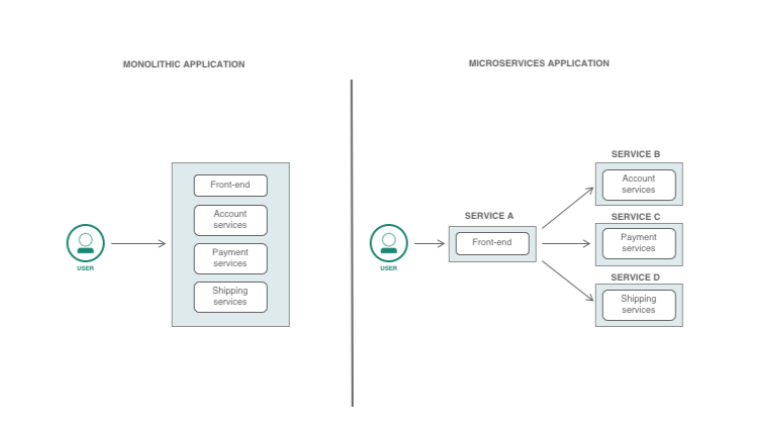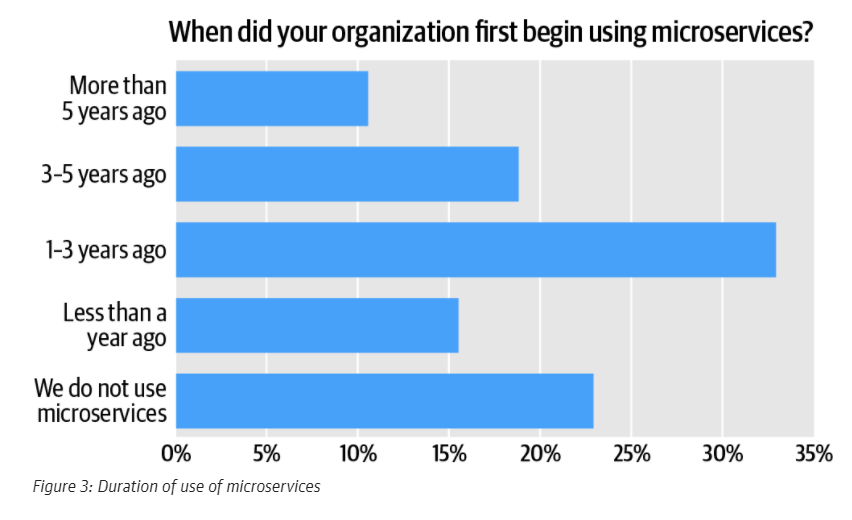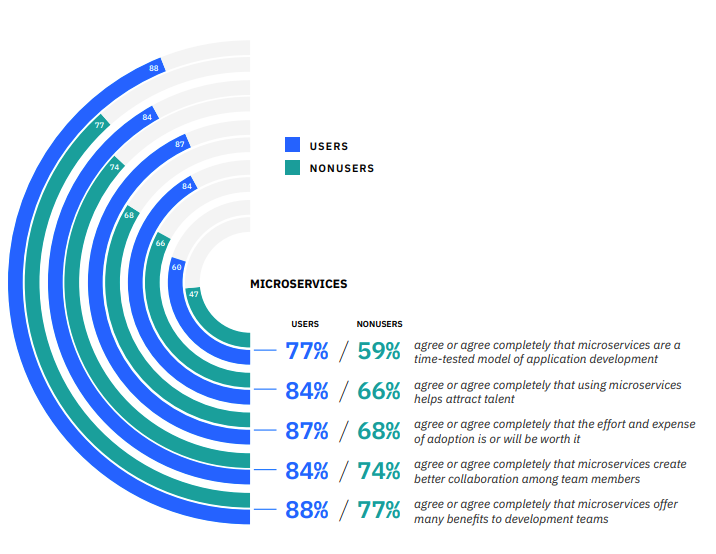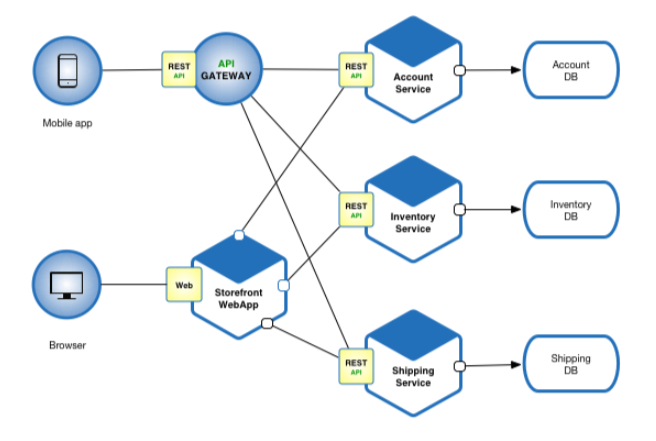Developing enterprise applications looks very different than it used to. As recently as 5-10 years ago, developers were still building monolithic applications – those that contain all the code for all the services an application provides- to be used internally.
For small businesses, monoliths can be a quick way to develop an application. But once their number of users, features, code, and developers grows, monoliths become vulnerable to crashes.
The issue arises because scaling a monolithic application quickly to handle extra load is expensive, technically challenging, and time-consuming. This results in crashes, service outages, frustrated users, and even business losses.
So what are your options? Enter microservices.
A microservice is a software development technique in which developers decouple monolithic applications into smaller, independent services that can communicate with each other seamlessly through APIs.
What is Microservices Architecture?
Microservices architecture lets you design enterprise applications as a collection of distributed services using TCP, HTTP, and other communication protocols to keep things in order. As a result, every business feature you offer or use can be handled by its own microservice.

Image: IBM
As opposed to relying on an extensive enterprise application that could fail due to overload, microservices employ multiple, independent services that can be run from different locations and computing environments.
Organizations are becoming more aware of these benefits. About 915 out of 1,500 software engineering professionals responded to a 2020 microservices adoption survey, saying they had used microservices for 1-5 years already.

Image: O’Reilly’s 2020 Microservices Adoption Survey
What are the Advantages of Microservices?
88% of the 1,056 IT executives, developers executives, and middle-level executives surveyed by IBM in 2021 either “agree” or “agree completely” that microservices offer many benefits.

Image: IBM’s Microservices in the enterprise, 2021: Real benefits worth the challenges
Here are some of the microservices benefits you should know:
1. Microservices are a simpler solution for enterprise-grade apps
Compared to monolithic applications of the same scope and purpose, microservices often utilize smaller code bases. As a result, microservices’ code is easier to track, understand, keep clean, troubleshoot, update, and manage for developers. Using microservices can help improve your development lifecycles and DevOps procedures.
2. You can deploy microservices to run many aspects of your business
Each microservice is a loosely coupled service, so you can correspond it to a business service. For example, an ecommerce business can use a microservice to manage each of the following services:
- Storefront
- Product catalog
- Inventory tracking
- Ordering
- Deliveries
- Account service
- Shopping cart abandonment
- Reviews
As an example, the microservices architecture below uses Rest API to ensure flawless communication between services:

Image: Microservices.io
As a result, you can keep all services running without interfering with each other’s workflows or workloads, resulting in an optimal user experiences.
3. Microservices architecture enables optimal scalability
One of the key features of microservices is their ability to be resized quickly, independently, and without downtime.
Growing organizations whose enterprise applications need to resize quickly to meet high activity levels will find this flexibility ideal. Microservices are also helpful for handling fluctuating traffic over time, as you can allocate more resources to in-demand services instead of the entire application, if need be.
Because decoupled applications can maintain standard performance under varying loads, they are more resilient and provide better user experiences.
4. With microservices, you can use the right tool for the right job
Another benefit of microservices is you can use different programming languages, frameworks, and compute resources for each one without affecting other parts of the system. You can use in-house tools, industry best practices, and even third-party integrations to deliver each microservice efficiently.
5. You can assign a unique team to manage and improve specific microservices
You can also assign separate teams to specific microservices. You can choose which team takes care of what microservices, based on the skill sets of its members. You can also hire professionals from anywhere in the world to manage specific microservices. The technology allows distributed teams to work on several components in multiple data centers or servers simultaneously.
6. Using microservices eases fault isolation
Microservices enable developers to conduct unit testing more efficiently than in monolithic applications because they can isolate decoupled components. This can help speed up the Minimum Time To Recovery (MTTR), which is the time to repair and recover from a system failure—in case it happens.
7. Microservices architecture enables developers to reduce downtime when repairing enterprise applications
Besides reducing MTTR, finding problematic microservices and isolating them early reduces crashes. Your users will benefit from high availability and reliable uptime as a result.
8. Microservices enable a DevOps culture
The DevOps philosophy borrows from the Agile Methodology of Continuous Integration and Continuous Delivery (CI/CD) for software development.
The goals of DevOps are typically to improve software time to market, to develop cost-effective software, and to continually improve applications. With microservices, you can work in individual services independently and test, improve, and deploy app updates where needed without affecting other microservices.
9. Microservices play well with containers
A container is an executable software unit that packages distributed components of an application and everything the components need to run seamlessly on any computing environment.
Containers and microservices are so well-suited to each other that many people use the two terms interchangeably. Yet, containers and microservices are different, and you can use either without the other. You can also use containers to deploy and run a monolithic application in a different environment from where you developed it.
The big benefit here is that using microservices with containers reduces the complexity of managing up to hundreds of microservices per application.
After containerizing your microservices, you can use a container orchestration tool such as Kubernetes or Docker to optimally manage most aspects of running microservices.
For example, Kubernetes enables engineers to automate deployment scheduling, scaling, self-healing, data backups, security protocols, and more microservices management tasks to reduce human error and save time and costs.
10. Microservices can be a cost-effective architecture for deploying enterprise applications
To optimize your engineering spend, you can choose the most cost-effective tool, best practice, and even computational resources for each microservice.
An orchestration tool can help you scale your application as needed, increasing or reducing the resources required to run it during peak and off-peak hours. A good cloud orchestration tool can automate this process to ensure you’re not paying for idle system time.
11. You can use microservices to modernize legacy enterprise applications
Microservices offer a cloud-native method of modernizing your software applications and migrating them to a cloud-based platform.
Even better, you don’t have to create a new application from scratch. By re-architecting your existing application to use a microservices architecture in a cloud environment, you can save time and money on development.
12. Organizations see microservices benefits within 2-6 months of the first deployment
Organizations that use microservices see improvements just two months after deploying microservices best practices, according to a RedHat survey.
In the O’Reilly survey referenced earlier, 825 out of 1,500 respondents said they had either complete success or some success using microservices. Further, over 78% of IBM’s 2021 surveyed executives said they would increase their microservices budgets, and 59% said they would adopt a microservices approach in the next two years. This speaks volumes about the benefits they see from their efforts.
13. You can achieve 5X faster time to market for new software than if you don’t use microservices
Microservices are the foundation upon which Amazon and Netflix deliver highly agile services globally. Do you know that they also release new code updates every 11.7 seconds and thousands of times a day, respectively?
With microservices, you can release a minimum viable product (MVP) and push updates to it on the go as you collect feedback from customers.
14. Microservices increase application and data security
Many IT executives and developers see benefits from deploying microservices when it comes to customer data protection and application security.
Yet, despite all of these benefits, managing, optimizing, and deploying microservices architecture requires expertise. Otherwise, an application with thousands or hundreds of microservices can become too complex—from management issues to security vulnerabilities and cost overruns.
The Simpat Tech Team Can Help
At Simpat Tech, we recommend working with an experienced microservices professional if you don’t have experienced or enough personnel on staff.
Our team of engineers has significant experience in developing microservices, containerizing software, orchestrating cloud applications, and re-architecting existing legacy applications to help you. Talk to us today about making microservices work for you and your business.